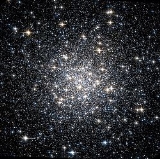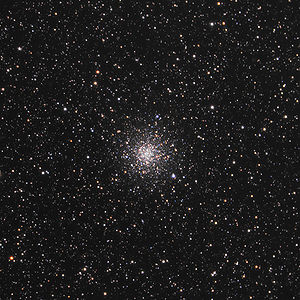
Messier 56
Encyclopedia

Globular cluster
A globular cluster is a spherical collection of stars that orbits a galactic core as a satellite. Globular clusters are very tightly bound by gravity, which gives them their spherical shapes and relatively high stellar densities toward their centers. The name of this category of star cluster is...
in the constellation
Constellation
In modern astronomy, a constellation is an internationally defined area of the celestial sphere. These areas are grouped around asterisms, patterns formed by prominent stars within apparent proximity to one another on Earth's night sky....
Lyra
Lyra
Lyra is a small constellation. It is one of the 48 constellations listed by the 2nd century astronomer Ptolemy, and remains one of the 88 modern constellations recognized by the International Astronomical Union. Its principal star, Vega — a corner of the Summer Triangle — is one of the brightest...
. It was discovered by Charles Messier
Charles Messier
Charles Messier was a French astronomer most notable for publishing an astronomical catalogue consisting of deep sky objects such as nebulae and star clusters that came to be known as the 110 "Messier objects"...
in 1779. M56 is at a distance of about 32,900 light-year
Light-year
A light-year, also light year or lightyear is a unit of length, equal to just under 10 trillion kilometres...
s from Earth
Earth
Earth is the third planet from the Sun, and the densest and fifth-largest of the eight planets in the Solar System. It is also the largest of the Solar System's four terrestrial planets...
and measures roughly 84 light-years across.
The brightest star
Star
A star is a massive, luminous sphere of plasma held together by gravity. At the end of its lifetime, a star can also contain a proportion of degenerate matter. The nearest star to Earth is the Sun, which is the source of most of the energy on Earth...
s in M56 are of 13th magnitude
Apparent magnitude
The apparent magnitude of a celestial body is a measure of its brightness as seen by an observer on Earth, adjusted to the value it would have in the absence of the atmosphere...
while it contains only about a dozen known variable star
Variable star
A star is classified as variable if its apparent magnitude as seen from Earth changes over time, whether the changes are due to variations in the star's actual luminosity, or to variations in the amount of the star's light that is blocked from reaching Earth...
s, such as V6 (RV Tauri star
RV Tauri variable
RV Tauri variables are supergiant variable stars. They exhibit changes in luminosity which are tied to radial pulsations of their surfaces. Their changes in brightness are also correlated with changes in their spectral type. While at their brightest, the stars have spectral types F or G. At...
; period: 90 days) or V1 (Cepheid: 1.510 days); other variable stars are V2 (irregular) and V3 (semiregular).

